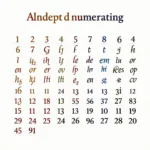Valency in chemistry, or simply valency, is the combining power of an element. Understanding valency is crucial for writing chemical formulas and predicting how elements will interact. This article will explore the concept of valency, its importance, and how it relates to other chemical principles.
Understanding Valency (Hiểu về Hóa Trị)
Valency, in its simplest form, refers to the number of bonds an atom of a particular element can form with other atoms. This bonding capacity is determined by the number of electrons in the outermost shell of the atom, also known as the valence shell. Elements strive to achieve a stable electron configuration, often by filling their valence shell. This drive leads to the formation of chemical bonds. For example, hydrogen has a valency of 1 because it needs one more electron to fill its valence shell. Oxygen, with a valency of 2, requires two electrons to achieve stability.
Importance of Valency in Chemistry (Tầm quan trọng của Hóa trị trong Hóa học)
Valency plays a vital role in predicting the formulas of chemical compounds. Knowing the valency of each element involved allows us to determine the ratio in which they will combine. For instance, knowing that hydrogen has a valency of 1 and oxygen has a valency of 2 helps us understand why water’s formula is H₂O. Two hydrogen atoms are needed to satisfy the combining power of one oxygen atom. Understanding các thuật ngữ toán học bằng tiếng anh can also be beneficial for understanding complex chemical equations.
Valency vs. Oxidation State (Hóa trị và Trạng thái Oxy hóa)
While often used interchangeably, valency and oxidation state are not identical concepts. Valency is a fixed property of an element, representing its maximum combining power. Oxidation state, on the other hand, describes the apparent charge of an atom within a molecule and can vary depending on the compound. For example, while sulfur’s valency is typically 2, 4, or 6, its oxidation state can range from -2 to +6 depending on the specific chemical environment. Thinking about how to học cách im lặng để sống khôn ngoan hơn might be helpful in understanding this difference.
How to Determine Valency (Cách xác định Hóa trị)
The valency of an element can be determined by examining its electron configuration. The number of electrons needed to complete the outermost shell or the number of electrons that can be readily lost or gained determines the element’s valency.
Valency and the Periodic Table (Hóa trị và Bảng tuần hoàn)
The valency of elements follows a general pattern within the periodic table. Elements in the same group (vertical column) typically have the same valency. This is because elements in the same group have the same number of valence electrons. Understanding the periodic table can also be helpful when exploring topics like hệ học 12 12 tiếng anh. Even considering du học pháp ngành y can benefit from a strong foundation in chemical principles like valency.
Perhaps you’re wondering about the giá vé viện hải dương học nha trang? That’s a fascinating place to see marine life and appreciate the complex chemistry of the ocean.
In conclusion, understanding valency—the combining power of an element—is fundamental in chemistry. It helps predict chemical formulas, understand how elements interact, and appreciate the underlying principles governing the formation of compounds. Mastering this concept is a cornerstone for further exploration in the world of chemistry.
FAQ
- What is the valency of carbon? Carbon typically has a valency of 4.
- Why is valency important? Valency is crucial for predicting the formulas of chemical compounds and understanding chemical reactions.
- How is valency different from oxidation state? Valency is a fixed property related to the combining power of an element, while oxidation state is the apparent charge of an atom in a molecule and can vary.
- How can I find the valency of an element? The valency can be determined from the element’s electron configuration.
- Does valency change across the periodic table? Yes, valency generally follows a pattern within the periodic table, with elements in the same group having the same valency.
- What is the relationship between valency and chemical bonding? Valency dictates the number of bonds an atom can form, directly influencing the type and strength of chemical bonds.
- Can an element have more than one valency? Yes, some elements exhibit variable valency, meaning they can have different combining powers depending on the compound.
Khi cần hỗ trợ hãy liên hệ Số Điện Thoại: 0705065516, Email: thptquangtrung@gmail.com Hoặc đến địa chỉ: NB tổ 5/110 KV bình thường b, P, Bình Thủy, Cần Thơ, Việt Nam. Chúng tôi có đội ngũ chăm sóc khách hàng 24/7.


